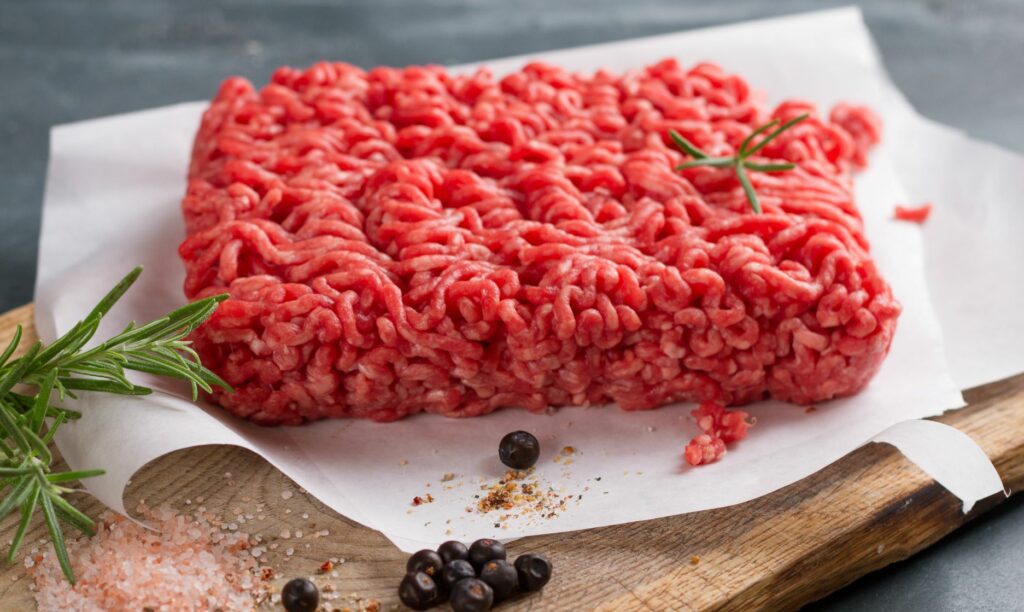What’s in ground beef? Penn State Meat Scientist Answers Your Ground Beef Questions
August 17, 2022
August 17, 2022
At Nicholas Meat, we get asked a lot of questions about beef – especially ground beef. It’s the most convenient, versatile and tasty beef product out there! Ground beef is consumed in a variety of ways from traditional cheeseburgers and spaghetti to tacos and chili. It shouldn’t surprise anyone to hear that more than 50 percent of all beef consumed is ground beef. To learn more about this popular meat and get your questions answered, we talked to Jonathan Campbell, Ph.D., an associate professor in the Department of Animal Science at Penn State to learn more!

Question: When I buy ground beef at the grocery store, what am I buying?
Answer: The definition of ground beef is very specific according to the Code of Federal Regulations: “Chopped Beef” or “Ground Beef” shall consist of chopped fresh and/or frozen beef with or without seasoning and without the addition of beef fat as such, shall not contain more than 30 percent fat, and shall not contain added water, phosphates, binders, or extenders.
This standard of identity says packers and processors cannot add anything to ground beef, except for meat. You cannot add water. You cannot add phosphate. You cannot add binders or extenders. You cannot add organ meats to ground beef. It must be 100% beef from the carcass of that animal. (Note: Nicholas Meat does not grind and sell ground beef. We sell beef to others for further processing and distribution.)
Question: What about products labeled as hamburger patties or beef patties that I buy at the store? Are there additives in those types of items?
Answer: If the package is labeled ground beef, there can’t be any additives. If you buy beef patties, this allows binders and extenders – like soy protein isolate – to be added to help the meat go further and help lower the cost of the product. Note, however, that sometimes in the marketplace you might see a label stating “100% pure beef” and that is meant to distinguish the product from other beef patties that have additives. My advice – always read the label to know what’s in your food.
Question: What are the differences between products like Ground Chuck, Ground Sirloin and Ground Round?
Answer: The difference between these ground beef products is the ratio of lean meat and fat. A good standard for Ground Chuck is that it’s about 80% lean and 20% fat. Ground Sirloin and Ground Round are leaner cuts and could be 85/15, 90/10 or 95/5. Each grocery store has a fat specification that they want to carry in their store that is related to consumer demand. Typically, the lower the fat content, the less flavorful the meat will be when cooked.
Information Brief: What’s in ground beef?
Question: When my pound of ground beef thaws, what is the liquid that comes from the meat? Is that blood?
Answer: What you’re seeing is water and colored protein called myoglobin – not blood. The red liquid or juice from raw beef is a combination of water, which makes up about 65-75 percent of meat, and a protein found in muscle tissue called myoglobin. It looks like blood on your plate because the iron in myoglobin turns red when it is exposed to oxygen. That’s why muscle tissue is red. Most mammals have plenty of myoglobin in their tissue, which is why beef is known as ‘red meat.’ Also don’t panic if your ground beef is red on the outside and grayish brown on the inside. It’s all about air. The pigment in meat changes colors when exposed to oxygen.

Question: What temperature should ground beef reach when cooking it and why?
Answer: Consumers should cook ground beef to an internal temperature of 160 °F. When you grill a steak, for example, that’s a whole muscle cut and only the outside of the meat is likely to have been exposed to harmful bacteria like E. coli. However, ground beef is ground together so internal muscle fibers and the surface of the meat are co-mingled. This means surface contamination can be found within the ground beef. Salmonella and E. coli are both destroyed at 160 °F therefore, it’s best to cook ground beef to that temperature. Harmful bacteria cannot be seen or smelled, so use a meat thermometer. Additionally, it is important to store ground beef at 40 °F (4.4 °C) or below and use within two days or freeze it if it is not going to be used right away. (Note: Beef at Nicholas Meat is tested for E. coli and federally inspected prior to distribution to others.)
Question: Any final advice for consumers when they look to purchase beef in the future?
Answer: Yes, try to be a smart, educated consumer. Read the label and use a cooking thermometer.
Question: What’s your favorite cut of beef?
Answer: I would have to say a chuck eye steak. It’s sometimes called a Delmonico steak too. It’s not a huge portion and the beef flavor in this cut of meat is just fantastic!
Now that you know more about ground beef, check out some recipes. The Pioneer Woman provides 60 Best Ground Beef Recipes for budget-friendly dinners. You’ll find recipes for sliders, pizza, meatballs, casseroles, lasagna, burritos and more! Enjoy! If you’d like to know more about ground beef and food safety visit this USDA website: Ground Beef and Food Safety | Food Safety and Inspection Service.